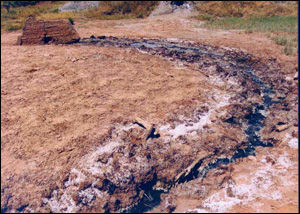NSF approves $1.3 million for OSU and OU microbes hunt
Tuesday, August 26, 2008

The sulphur-rich Zodletone Spring gurgles from the ground near Anadarko.
“During the last two decades, advances in techniques used to identify microorganisms have proven that a large number of unknown communities exist in nature, and Zodletone Spring (30 miles west of Anadarko) has several unique features perfect for this study,” said Dr. Mostafa Elshahed, assistant professor in the microbiology and molecular genetics department at Oklahoma State University, and the lead investigator for the grant. “The spring has high sulfide and sulfur concentrations, high levels of gaseous hydrocarbons, and an absence of oxygen that makes it ideal to study and hunt for many of these unique bacteria.”
Researchers will use the spring as a microbial observatory to identify and study four different groups of bacteria, their metabolic capabilities, and ecological role in the spring, according to Elshahed. Along with genomic (DNA-based) studies, these groups of bacteria will be cultivated and studied in the laboratory.
“Because these bacteria come from an environment in which oxygen is rare, some sophisticated isolation strategies will be used in the laboratory as we verify their environmental role and avoid the presence of oxygen which can kill them,” said Elshahed.
The grant will also fund an educational outreach component that will allow high school students to get involved in the project. They will be asked to participate in a summer laboratory to conduct research and present findings at a symposium through the Junior Science and Humanities Symposia at Oklahoma State University.
“Our team is very happy to be chosen to receive this grant in a program that approves only 10 percent of the grant proposals that are submitted,” said Elshahed, who together with Dr. Caroline Beller, assistant professor of education, are the lead researchers for the project at OSU. Dr. Lee Krumholz, associate professor of botany and microbiology, is the lead researcher at the University of Oklahoma. Of the total grant, $800,000 will go to OSU and $500,000 to OU.
